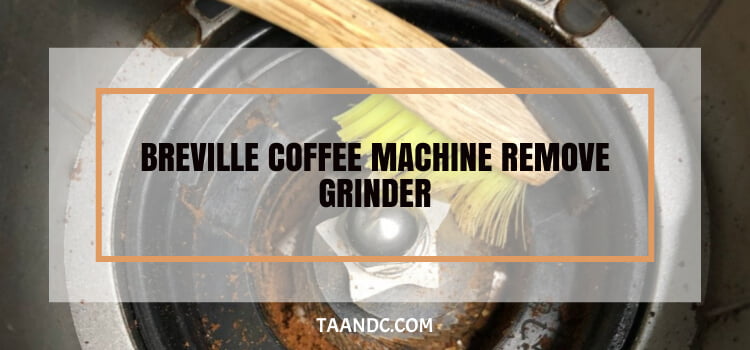So, you're ready to fine-tune your coffee game and explore new grounds with your Breville coffee machine. Removing the grinder is a cinch, especially if you've been tinkering with your machine for a while. Start by unplugging your Breville and giving it a once-over to ensure safety. Then, depending on your model, locate the grinder compartment and follow the manufacturer's instructions. It usually involves simple steps, like unlocking and gently pulling out the grinder. With some finesse, your grinder-free setup will be ready to go, opening doors to endless coffee possibilities.

Understanding the Breville Coffee Machine
The Breville coffee machine is a marvel of modern engineering, designed to bring the perfect cup of coffee into your home. To truly master its operation, it's essential to understand its components and their functions clearly. First, let's look at the key elements that make up the Breville coffee machine. You'll find the water reservoir, which stores the water needed for brewing. This component is typically located at the rear or side of the machine, and it's crucial to ensure it's adequately filled before starting the brewing process.
Next in line is the drip tray situated at the base. This serves as a safeguard, collecting any excess liquid that may escape during brewing. Regular emptying of the drip tray is essential to prevent overflow and maintain cleanliness. Now, let's delve into the heart of the Breville coffee machine: the grinder. This pivotal component transforms whole coffee beans into the acceptable grounds necessary for brewing. Understanding the grinder's settings and adjustments allows you to customize your grounds' coarseness, influencing your coffee's flavor profile.
The grinder plays an integral role in the coffee-making process. Its precision ensures that each grind is uniform, resulting in a consistent extraction. This, in turn, directly impacts your brew's flavor, aroma, and strength. It's worth noting that different types of coffee, such as espresso or French press, require distinct grind sizes to achieve optimal results.
In essence, comprehending the components of the Breville coffee machine, with a particular focus on the grinder, sets the stage for a genuinely exceptional brewing experience. Fine-tuning the sub to suit your taste preferences is a skill that elevates your coffee-making prowess and allows you to savor every cup to the fullest.
Preparation & Safety Measures
Before removing the grinder from your Breville coffee machine, being well-prepared and mindful of safety precautions is essential. This ensures a smooth process and safeguards you and your machine from mishaps. Begin by gathering the necessary tools and materials. You'll require a set of screwdrivers, typically Phillips and flat-head, to handle any screws securing the grinder in place. Additionally, a clean cloth or paper towel is advisable for wiping away any coffee residue or dust that may have accumulated.
Safety should always be a top priority, so let's discuss some crucial precautions. First and foremost, ensure that the machine is entirely powered off and unplugged from the electrical outlet. This eliminates any risk of electrical shocks during the process. It's also wise to let the machine cool down if it has been in use recently, as specific components may still retain heat. Another vital safety measure is to work in a well-lit and spacious area. This allows for better visibility and maneuverability, reducing the likelihood of accidents. A clear workspace free from clutter is also advisable, ensuring ample room to maneuver and work comfortably.
Furthermore, your Breville coffee machine comes with a user manual. In that case, it's highly recommended to consult it for manufacturer-specific instructions or precautions for removing the grinder. Manufacturers often provide specific guidelines to ensure the process is carried out correctly and safely. Taking these preparatory steps and adhering to safety measures set the stage for a hassle-free and secure grinder removal process. These precautions protect your machine and ensure your well-being throughout the procedure. Remember, a little preparation goes a long way in ensuring a successful outcome.
Step-by-Step Guide: Breville Coffee Machine Grinder Removal
Knowing how to remove the grinder is crucial for maintaining your Breville coffee machine. This step-by-step guide will walk you through the process, ensuring a seamless experience.
Step 1: Powering off and Unplug the Machine
Begin by ensuring the safety of the operation. If available, turn off the machine using the designated power button. Next, reach for the plug and gently disconnect it from the electrical outlet. This step is paramount in preventing any electrical mishaps during the process.
Step 2: Emptying the Bean Hopper
Before delving into the grinder removal, clearing out any remaining coffee beans from the bean hopper is essential. Gently lift off the hopper lid and carefully scoop out the beans. This ensures a clean workspace and makes the subsequent steps much more manageable.
Step 3: Detaching the Bean Hopper
With the bean hopper emptied, it's time to remove it from the machine. Typically, the hopper is secured with a locking mechanism or a series of screws. Follow the manufacturer's instructions to disengage this attachment, allowing you to lift the hopper away from the machine.
Step 4: Accessing the Grinder Mechanism
Now that the bean hopper is removed, you'll see the internal components. Locate the grinder mechanism, typically housed near the top of the machine. Depending on the model, you may need to remove an additional cover or panel to gain full access.
Step 5: Removing the Grinder
This is the crux of the operation. Carefully inspect the grinder for securing mechanisms, such as screws or clips. Once identified, use the appropriate tool to loosen and detach them. With the securing elements removed, gently lift or slide the grinder out from its housing.
By following these steps diligently, you'll successfully navigate removing the grinder from your Breville coffee machine. Patience and precision are essential, ensuring that each step is executed with care. This maintenance task not only prolongs the life of your machine but also guarantees a fresh and consistent brew with every use.
Cleaning & Maintenance Tips
Keeping your Breville coffee machine in optimal condition ensures a delicious brew and extends its lifespan. This section covers essential cleaning and maintenance practices to keep your machine running smoothly.
Offering Guidance on Cleaning
Begin by unplugging the machine and allowing it to cool down completely. Once safe to touch, remove the grinder according to the earlier steps. Use a small brush with soft bristles to gently remove coffee particles from the grinder blades and surrounding areas. Consider using a specialized grinder cleaning brush or a grinder cleaning tablet for a deeper clean. These aids are designed to remove oils and residues that can affect the flavor of your coffee.
Moving on to the bean hopper and other removable parts, wash them with warm, soapy water. Ensure thorough rinsing and allow them to air dry before reassembling. As for the exterior, a damp cloth will suffice to wipe away any coffee splatters or fingerprints. Be cautious not to use abrasive materials that could damage the surface.
Providing Recommendations for Maintaining
Regular maintenance goes beyond cleaning. It involves critical practices to keep your Breville coffee machine in top-notch shape. Firstly, descaling is essential to remove mineral buildup inside the machine. Follow the manufacturer's guidelines on how often to perform this task and which descaling solution to use.
Another vital step is checking the water filter, if applicable. Replace it with the recommended schedule to ensure your machine produces clean and flavorful coffee. Additionally, keep an eye on the rubber seals and gaskets. Worn or damaged seals can lead to leaks and affect the machine's performance. Replace them as needed to maintain a tight seal.
Consult the user manual for the manufacturer's specific maintenance instructions. These guidelines are tailored to your particular Breville coffee machine model and are invaluable for long-term care. By adhering to these cleaning and maintenance tips, you'll enjoy consistently great-tasting coffee and extend the life of your beloved Breville coffee machine. Remember, a little regular upkeep goes a long way in preserving the quality of your brews.
Read More: Breville Barista Touch vs Philips 3200: Which Coffee Machine Reigns Supreme?
Troubleshooting Common Issues
Encountering challenges while working on your Breville coffee machine is not uncommon. This section addresses some of the most frequent issues and offers practical solutions to get your machine back on track.
Addressing Potential Challenges
Grinder Jamming: One common issue you might face is grinder jamming, often due to the presence of foreign objects or excessive coffee bean oil. In such cases, power off the machine, unplug it and carefully inspect the grinder for obstructions. Use a wooden or plastic tool to gently dislodge any stuck particles. Clean the grinder thoroughly before reassembly.
Difficulties Detaching the Bean Hopper: If you need help removing the bean hopper, it might be because residual oils or coffee grounds are causing a sticky residue. Try wiping the area around the hopper with a clean, damp cloth to remove any buildup. If the issue persists, consider using a food-safe degreaser to dissolve the residue.
Providing Solutions & Tips
Uneven Grinding: If your coffee grounds are coming out uneven, it's likely an issue with the grinder settings. Adjust the grind size to a finer or coarser setting, depending on the desired result. Refer to your machine's manual for specific guidance on adjusting grind settings.
Machine Not Powering: If the machine fails to power on after reassembly, double-check that it's securely plugged in and that the outlet is functioning. Also, ensure that the machine is reassembled correctly, as some models have safety mechanisms that prevent operation if not fully assembled.
Unusual Noises: Unusual noises during operation can indicate a misaligned or improperly reassembled component. Power off the machine and carefully inspect all parts for correct placement and alignment. Additionally, ensure that no foreign objects are obstructing any moving parts.
By addressing these potential challenges and applying the provided solutions, you'll be better equipped to navigate any hiccups that may arise during the grinder removal process. Patience and careful attention to detail are critical to successfully troubleshooting and resolving these issues.
Read More: Breville Coffee Maker with Grinder Problems: Troubleshooting
Reassembling Breville Coffee Machine
Now that you've successfully removed the grinder from your Breville coffee machine, it's time to guide you through the crucial process of putting everything back together. Ensuring all components are securely in place is vital for the machine's proper functioning. Begin by aligning the grinder with its housing. Gently slide or lower it back into position, taking care not to force it. If there were any securing mechanisms, such as screws or clips, ensure they are reattached snugly to hold the grinder securely in place.
Next, reattach the bean hopper. Align it with the designated grooves or slots, ensuring it fits snugly. Depending on your specific model, you may need to engage a locking mechanism or reinsert screws to secure the hopper. Take a moment to double-check all other removable components, such as the water reservoir and drip tray. Ensure they are appropriately placed and securely fastened. This step is crucial in preventing any potential leaks or malfunctions.
Finally, power the machine and run a test cycle without coffee beans to ensure everything functions. Listen for any unusual noises or observe any irregularities in operation. You can now enjoy your freshly brewed coffee if everything appears in order. By following these steps and paying close attention to the reassembly process, you can be confident that your Breville coffee machine is ready to deliver delicious cups of coffee once again. Patience and precision are crucial to ensuring all components are correctly secured, guaranteeing a seamless brewing experience.
Final Checks & Testing
As you near the completion of the grinder removal process in your Breville coffee machine, it's crucial to perform thorough checks to ensure everything is in order. This step is vital for a seamless brewing experience and the longevity of your machine. Begin by carefully inspecting all components. Check for any loose parts, including screws, clips, or fasteners. Ensure everything is securely in place, leaving no room for potential malfunctions or accidents during operation.
Next, it's time to test your Breville coffee machine. Power it on and run a test cycle without coffee beans in the grinder. Listen closely for any unusual noises or vibrations. Observe the flow of water and ensure it's consistent and uninterrupted. While the machine operates, pay special attention to areas around the grinder housing and the bean hopper. Watch for any signs of leakage or dripping. If you notice any, immediately power off the machine and recheck the assembly of these components.
Once you've completed the test cycle and are satisfied with the machine's performance, you can rest assured that your Breville coffee machine will brew exceptional cups of coffee again. By conducting these final checks and testing procedures, you ensure that your machine is in optimal condition and ready to deliver consistently great coffee. Remember, attention to detail and a keen eye for potential issues are critical to a successful grinder removal process.
Read More: Can You Brew Coffee Beans Without Grinding? Grinding or Not
FAQ
How often should I remove and clean the grinder in my Breville coffee machine?
It's recommended that the grinder be cleaned every 2-4 weeks, depending on usage. This helps maintain the quality of your coffee and extends the machine's life.
Can I remove the grinder without special tools or skills?
Yes, you can remove the grinder with essential household tools like screwdrivers. Just follow the step-by-step guide provided in the manual or our blog post.
What if I encounter resistance while removing the grinder?
Double-check that the machine is powered off and unplugged if you face resistance. Ensure you've followed each step correctly, and don't force any components. If issues persist, consult the user manual or seek professional assistance.
Is it necessary to empty the bean hopper before removing the grinder?
Emptying the bean hopper is essential to prevent any spills or messes during removal. This also ensures a clean workspace and makes handling the machine easier.
How do I know if I've reassembled the machine correctly after grinder removal?
After reassembly, perform a test cycle without coffee beans. Listen for unusual noises, check leaks, and ensure all components are securely in place. If everything operates smoothly, you've successfully reassembled the machine.
Conclusion
Mastering the "Breville coffee machine remove grinder" process is a valuable skill for any coffee enthusiast. It not only ensures the longevity of your machine but also grants you greater control over the quality of your brews. With regular maintenance and a clear understanding of removing and cleaning the grinder, you'll continue to enjoy the decadent, aromatic cups of coffee that Breville machines are known for. So, embrace this essential maintenance routine and keep your coffee adventures consistently satisfying.


